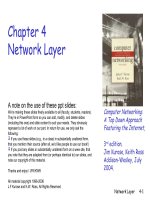Application Layer
Bạn đang xem bản rút gọn của tài liệu. Xem và tải ngay bản đầy đủ của tài liệu tại đây (890.95 KB, 109 trang )
2: Application Layer 1
Chapter 2
Application Layer
Computer Networking:
A Top Down Approach
Featuring the Internet
,
3
rd
edition.
Jim Kurose, Keith Ross
Addison-Wesley, July
2004.
A note on the use of these ppt slides:
We’re making these slides freely available to all (faculty, students, readers).
They’re in PowerPoint form so you can add, modify, and delete slides
(including this one) and slide content to suit your needs. They obviously
represent a lot of work on our part. In return for use, we only ask the following:
If you use these slides (e.g., in a class) in substantially unaltered form, that
you mention their source (after all, we’d like people to use our book!)
If you post any slides in substantially unaltered form on a www site, that
you note that they are adapted from (or perhaps identical to) our slides, and
note our copyright of this material.
Thanks and enjoy! JFK/KWR
All material copyright 1996-2006
J.F Kurose and K.W. Ross, All Rights Reserved
2: Application Layer 2
Chapter 2: Application layer
❒
2.1 Principles of
network applications
❒
2.2 Web and HTTP
❒
2.3 FTP
❒
2.4 Electronic Mail
SMTP, POP3, IMAP
❒
2.5 DNS
❒
2.6 P2P file sharing
❒
2.7 Socket programming
with TCP
❒
2.8 Socket programming
with UDP
❒
2.9 Building a Web
server
2: Application Layer 3
Chapter 2: Application Layer
Our goals:
❒
conceptual,
implementation
aspects of network
application protocols
transport-layer
service models
client-server
paradigm
peer-to-peer paradigm
❒
learn about protocols
by examining popular
application-level
protocols
HTTP
FTP
SMTP / POP3 / IMAP
DNS
❒
programming network
applications
socket API
2: Application Layer 4
Some network apps
❒
❒
Web
❒
Instant messaging
❒
Remote login
❒
P2P file sharing
❒
Multi-user network
games
❒
Streaming stored
video clips
❒
Internet telephone
❒
Real-time video
conference
❒
Massive parallel
computing
❒
❒
❒
2: Application Layer 5
Creating a network app
Write programs that
run on different end
systems and
communicate over a
network.
e.g., Web: Web server
software communicates
with browser software
little software written for
devices in network core
network core devices do
not run user application
code
application on end systems
allows for rapid app
development, propagation
application
transport
network
data link
physical
application
transport
network
data link
physical
application
transport
network
data link
physical
2: Application Layer 6
Chapter 2: Application layer
❒
2.1 Principles of
network applications
❒
2.2 Web and HTTP
❒
2.3 FTP
❒
2.4 Electronic Mail
SMTP, POP3, IMAP
❒
2.5 DNS
❒
2.6 P2P file sharing
❒
2.7 Socket programming
with TCP
❒
2.8 Socket programming
with UDP
❒
2.9 Building a Web
server
2: Application Layer 7
Application architectures
❒
Client-server
❒
Peer-to-peer (P2P)
❒
Hybrid of client-server and P2P
2: Application Layer 8
Client-server architecture
server:
always-on host
permanent IP address
server farms for scaling
clients:
communicate with
server
may be intermittently
connected
may have dynamic IP
addresses
do not communicate
directly with each other
2: Application Layer 9
Pure P2P architecture
❒
no always-on server
❒
arbitrary end systems
directly communicate
❒
peers are intermittently
connected and change IP
addresses
❒
example: Gnutella
Highly scalable but
difficult to manage
2: Application Layer 10
Hybrid of client-server and P2P
Skype
Internet telephony app
Finding address of remote party: centralized server(s)
Client-client connection is direct (not through server)
Instant messaging
Chatting between two users is P2P
Presence detection/location centralized:
•
User registers its IP address with central server when it
comes online
•
User contacts central server to find IP addresses of
buddies
2: Application Layer 11
Processes communicating
Process: program running
within a host.
❒
within same host, two
processes communicate
using inter-process
communication (defined
by OS).
❒
processes in different
hosts communicate by
exchanging messages
Client process: process
that initiates
communication
Server process: process
that waits to be
contacted
❒
Note: applications with
P2P architectures have
client processes &
server processes
2: Application Layer 12
Sockets
❒
process sends/receives
messages to/from its
socket
❒
socket analogous to door
sending process shoves
message out door
sending process relies on
transport infrastructure on
other side of door which
brings message to socket at
receiving process
process
TCP with
buffers,
variables
socket
host or
server
process
TCP with
buffers,
variables
socket
host or
server
Internet
controlled
by OS
controlled by
app developer
❒
API: (1) choice of transport protocol; (2) ability to fix
a few parameters (lots more on this later)
2: Application Layer 13
Addressing processes
❒
to receive messages,
process must have
identifier
❒
host device has
unique32-bit IP
address
❒
Q: does IP address of
host on which process
runs suffice for
identifying the
process?
2: Application Layer 14
Addressing processes
❒
to receive messages,
process must have
identifier
❒
host device has
unique32-bit IP
address
❒
Q: does IP address of
host on which process
runs suffice for
identifying the
process?
Answer: NO, many
processes can be running
on same host
❒
identifier
includes both
IP address and port
numbers associated with
process on host.
❒
Example port numbers:
HTTP server: 80
Mail server: 25
❒
to send HTTP message
to gaia.cs.umass.edu web
server:
IP address: 128.119.245.12
Port number: 80
❒
more shortly…
2: Application Layer 15
App-layer protocol defines
❒
Types of messages
exchanged,
e.g., request, response
❒
Message syntax:
what fields in messages &
how fields are delineated
❒
Message semantics
meaning of information in
fields
❒
Rules for when and how
processes send &
respond to messages
Public-domain protocols:
❒
defined in RFCs
❒
allows for
interoperability
❒
e.g., HTTP, SMTP
Proprietary protocols:
❒
e.g., KaZaA
2: Application Layer 16
What transport service does an app need?
Data loss
❒
some apps (e.g., audio) can
tolerate some loss
❒
other apps (e.g., file
transfer, telnet) require
100% reliable data
transfer
Timing
❒
some apps (e.g.,
Internet telephony,
interactive games)
require low delay to be
“effective”
Bandwidth
❒
some apps (e.g.,
multimedia) require
minimum amount of
bandwidth to be
“effective”
❒
other apps (“elastic
apps”) make use of
whatever bandwidth
they get
2: Application Layer 17
Transport service requirements of common apps
Application
file transfer
Web documents
real-time audio/video
stored audio/video
interactive games
instant messaging
Data loss
no loss
no loss
no loss
loss-tolerant
loss-tolerant
loss-tolerant
no loss
Bandwidth
elastic
elastic
elastic
audio: 5kbps-1Mbps
video:10kbps-5Mbps
same as above
few kbps up
elastic
Time Sensitive
no
no
no
yes, 100’s msec
yes, few secs
yes, 100’s msec
yes and no
2: Application Layer 18
Internet transport protocols services
TCP service:
❒
connection-oriented:
setup
required between client and
server processes
❒
reliable transport
between
sending and receiving process
❒
flow control:
sender won’t
overwhelm receiver
❒
congestion control:
throttle
sender when network
overloaded
❒
does not provide:
timing,
minimum bandwidth
guarantees
UDP service:
❒
unreliable data transfer
between sending and
receiving process
❒
does not provide:
connection setup,
reliability, flow control,
congestion control, timing,
or bandwidth guarantee
Q: why bother? Why is
there a UDP?
2: Application Layer 19
Internet apps: application, transport protocols
Application
remote terminal access
Web
file transfer
streaming multimedia
Internet telephony
Application
layer protocol
SMTP [RFC 2821]
Telnet [RFC 854]
HTTP [RFC 2616]
FTP [RFC 959]
proprietary
(e.g. RealNetworks)
proprietary
(e.g., Vonage,Dialpad)
Underlying
transport protocol
TCP
TCP
TCP
TCP
TCP or UDP
typically UDP
2: Application Layer 20
Chapter 2: Application layer
❒
2.1 Principles of
network applications
app architectures
app requirements
❒
2.2 Web and HTTP
❒
2.4 Electronic Mail
SMTP, POP3, IMAP
❒
2.5 DNS
❒
2.6 P2P file sharing
❒
2.7 Socket programming
with TCP
❒
2.8 Socket programming
with UDP
❒
2.9 Building a Web
server
2: Application Layer 21
Web and HTTP
First some jargon
❒
Web page consists of objects
❒
Object can be HTML file, JPEG image, Java
applet, audio file,…
❒
Web page consists of base HTML-file which
includes several referenced objects
❒
Each object is addressable by a URL
❒
Example URL:
www.someschool.edu/someDept/pic.gif
host name
path name
2: Application Layer 22
HTTP overview
HTTP: hypertext
transfer protocol
❒
Web’s application layer
protocol
❒
client/server model
client:
browser that
requests, receives,
“displays” Web objects
server:
Web server
sends objects in
response to requests
❒
HTTP 1.0: RFC 1945
❒
HTTP 1.1: RFC 2068
PC running
Explorer
Server
running
Apache Web
server
Mac running
Navigator
H
T
T
P
r
e
q
u
e
s
t
H
T
T
P
r
e
q
u
e
s
t
H
T
T
P
r
e
s
p
o
n
s
e
H
T
T
P
r
e
s
p
o
n
s
e
2: Application Layer 23
HTTP overview (continued)
Uses TCP:
❒
client initiates TCP
connection (creates socket)
to server, port 80
❒
server accepts TCP
connection from client
❒
HTTP messages (application-
layer protocol messages)
exchanged between browser
(HTTP client) and Web
server (HTTP server)
❒
TCP connection closed
HTTP is “stateless”
❒
server maintains no
information about
past client requests
Protocols that maintain
“state” are complex!
❒
past history (state) must
be maintained
❒
if server/client crashes,
their views of “state” may
be inconsistent, must be
reconciled
aside
2: Application Layer 24
HTTP connections
Nonpersistent HTTP
❒
At most one object is
sent over a TCP
connection.
❒
HTTP/1.0 uses
nonpersistent HTTP
Persistent HTTP
❒
Multiple objects can
be sent over single
TCP connection
between client and
server.
❒
HTTP/1.1 uses
persistent connections
in default mode
2: Application Layer 25
Nonpersistent HTTP
Suppose user enters URL
www.someSchool.edu/someDepartment/home.index
1a. HTTP client initiates TCP
connection to HTTP server
(process) at
www.someSchool.edu on port 80
2. HTTP client sends HTTP
request message
(containing
URL) into TCP connection
socket. Message indicates
that client wants object
someDepartment/home.index
1b. HTTP server at host
www.someSchool.edu waiting
for TCP connection at port 80.
“accepts” connection,
notifying client
3. HTTP server receives request
message, forms
response
message
containing requested
object, and sends message
into its socket
time
(contains text,
references to 10
jpeg images)









